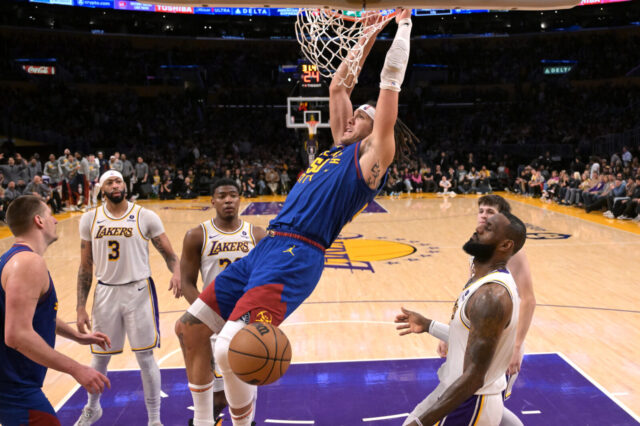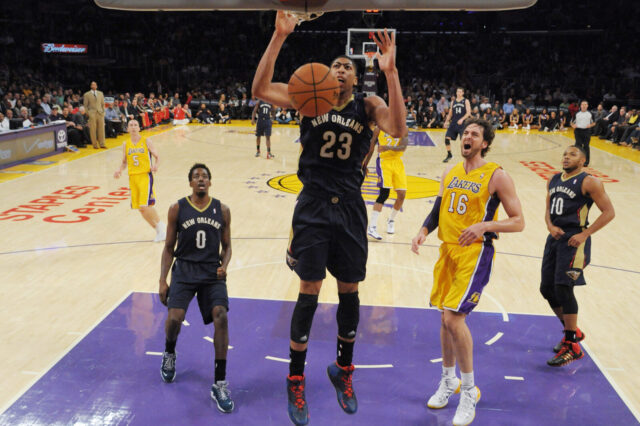This content is no longer available.
This content is no longer available.
This content is no longer available.
There are many ways to appreciate Paul Millsap.
You can seek out advanced metrics as I so often do, as they reflect kindly on Millsap’s time with the Denver Nuggets. ESPN’s Real Plus-Minus metric ranks him the 19th most impactful player in the NBA on a per-minute basis and the third most impactful power forward in 2018-19.
You can watch the games, as every Nuggets fan does, and understand that his back line defense is as invaluable as ever at 34 years old.
Or you can ask the Nuggets themselves. Players and coaches will be the first to say how valuable Millsap’s contributions have been over the last two seasons. Tim Connelly spoke about him in his exit interview last Monday:
“Paul [Millsap] is everything we hoped [for]. Culturally, on-court, impact, I think it’s startling to see where we are defensively with and without Paul…our goal and Paul’s goal is to have him back…I’m pretty confident that will happen.”
Where the Nuggets would be without Paul Millsap is definitely startling. I wrote about Millsap specifically back in late March, and much of the rhetoric remains the same. The back line defense suffers without Paul Millsap, and there’s no easy way to replace that if the Nuggets decide to go another direction in free agency.
Defensive Ace
As great as Nikola Jokic is commanding an offense, he often needs assistance on the defensive end. He does his job frequently, but the athleticism and heavy offensive role limit the job he CAN do on the less glorious end. Millsap more than made up for it though, often guarding the opposing team’s best big man scorer unless it created matchup problems for the rest of the team.
But more than anything, Millsap’s versatility elevated Denver’s defense to new heights. Only three NBA starters managed to accumulate at least a 20% defensive rebounding rate, a 2% steal rate, and a 2% block rate in 2018-19: Millsap, Draymond Green, and Andre Drummond. Rebounding was one of Millsap’s bigger weaknesses following his wrist ligament injury last season, but he spent a considerable amount of time rehabbing and strengthening that wrist to the point that it doesn’t bother him during games. The result has been one of the better seasons from him defensively.
Millsap’s defensive plays almost come across as rude when he pokes the ball away from the offensive player.
“Oh, you wanted to score there? That’s nice. I’m going to take it now.”
Steals, in my opinion, are so much more impactful than blocks. They are demoralizing for the offensive team. It wasn’t JUST a good play by the defense. It was a mistake by the offense that can often cause consternation among teammates. This is Millsap’s effect. During most of the game, he can often be found poking and prodding at the ball in smart, efficient ways that don’t compromise the defensive scheme. Millsap is constantly forcing the offensive team to be better on that end and focus on holding onto the ball, adding another factor to think about other than scoring. When Millsap does poke the ball free, it often leads to live-ball turnovers, the best kind. These turn defense into offense and lead to runs for the Nuggets. How often did the Nuggets round off a 12-2 run this year starting with Millsap poking the ball free and causing defensive chaos?
The Nuggets were able to press up on the perimeter and extend their defense because of Millsap rotating through the paint. He consistently offered help when needed, supporting the system that allowed Jokic to extend his coverage on the pick and roll. Without Millsap’s intelligence and basketball IQ, that sort of defense is vulnerable to easy shots inside. The Nuggets still gave up their fair share of easy looks at the rim with Millsap in, but it’s a numbers game, and the Nuggets used those numbers to finish the year as the 10th best defense in the NBA.
Offensive Inconsistency
There were definitely some bad moments from Millsap on offense, but most of the time, he offered himself up as a consistent supporting option for the Nikola Jokic-Jamal Murray two-man game. Averaging 12.6 points and 2.0 assists, Millsap’s role varied throughout the year. Through the first 25 games of the season, Millsap was up at 13.6 points per game on a variety of play types, most notably in spot ups, post ups, and cuts along the baseline. Then, he broke his toe against the Charlotte Hornets and sat out close to four weeks. When he returned, he struggled, averaging under 10.0 points per game and shooting just 26.7% from three. He sat out another three games but came back to average 13.7 points per game to close the final 26 games of the year. So, for most of the year, he averaged respectable numbers for a fourth offensive option.
As a spot up shooter, Millsap isn’t elite for a power forward, but he’s good enough. In 164 spot up possessions, Millsap averaged a 1.06 points per possession (PPP), good for 70th percentile, 13th in efficiency among power forwards with as many possessions. That’s certainly good enough.
As a post up big, Millsap was also reasonably efficient. In 163 possessions, Millsap averaged 1.01 PPP, good for 72nd percentile and 2nd among power forwards behind only LaMarcus Aldridge. Millsap utilized a variety of moves and fakes, but the overall awkwardness to his post up game was beautiful in many ways.
One of my favorite moves of Paul’s is when he turns to face up his defender, drives right into their body and then pulls up short of a charge to hit the floater. Poetry in motion because nobody is expecting it and Millsap repeats it so easily.
Jokic is also an elite post up player, but having a second guy to attack mismatches and carry bench units became invaluable for Denver throughout the season and in the playoffs. With Millsap on and Jokic off the floor for 370 minutes during the regular season, the Nuggets generated a +7.9 Net Rating that had a lot to do with Millsap’s 1-on-1 scoring. It wasn’t the only thing keeping Denver afloat (hello Monte Morris) but it certainly aided the cause.
Finally, the crown jewel of the Denver offense, the Murray-Jokic two-man game, doesn’t work if Millsap struggles to space the floor properly. That doesn’t always mean at the three point line though, as cutting to the rim and being able to finish is important. Millsap’s 125 possessions cutting this year don’t necessarily stand out to many, but this play doesn’t happen without proper spacing from Millsap to take advantage of Jokic’s incredible vision.
There were problems of course. While Millsap was an efficient spot up shooter, he wasn’t always a threat to shoot from the perimeter. Only averaging 2.3 spot up attempts per game is very strange for a starting power forward in the NBA today. Floor spacing is at a premium, and in the playoffs where defenders are closing out with more effort and shooting windows are much smaller, Millsap struggled. He shot just 31.6% from beyond the arc in the playoffs and made multiple three-pointers in only three of the 14 playoff games.
And in the end, Millsap just couldn’t get shots to fall in the paint in the last two games. A 4/15 performance in Game 6 and a 3/13 performance in Game 7 underscored what was a great series against the Portland Trail Blazers in the Conference Semi Finals. He had great opportunities. They just didn’t drop in the final two games.
What to do with that contract?
As I said before, the Nuggets want Millsap back. Millsap wants the Nuggets too. He said it himself in his exit interview.
The problem, of course, is the money. $30 million is a lot to pay Millsap for his age 34 season, and that number represents the team option the Nuggets own for Millsap’s 2019-20 season. Exercise the option, and the Nuggets are pretty much capped out, roughly $11 million from luxury tax territory. Decline the option, and the Nuggets open up roughly $18 million in cap space (assuming they renounce cap holds on Trey Lyles, Tyler Lydon, and others).
There are multiple reasons to decline the team option, but the biggest one is the idea that a star free agent could consider the Nuggets. That doesn’t seem likely, given that Kevin Durant of the Golden State Warriors and Kawhi Leonard of the Toronto Raptors are the biggest names, and they will face off in the NBA Finals later this week. Those two guys are either staying put or heading to big markets in New York or Los Angeles.
The next tier of free agents is also intriguing. Jimmy Butler in a Nuggets uniform would solve Denver’s longest running issue of finding a player to defend small forwards long term. Khris Middleton would offer something similar. Beyond those two guys though, it’s difficult to see a path that involves acquiring a player that would be more valuable for the Nuggets than Millsap would be in the 2019-20 season. There are very few power forwards available in free agency with the defensive acumen to replace Millsap, and while names like Tobias Harris and Nikola Mirotic present interesting options as floor spacers, adding them may negatively impact the defense more than it positively impacts the offense. In addition, the Nuggets possess some possible offensive options at forward this year with healthy versions of Juancho Hernangomez and Michael Porter Jr. in tow.
So, while I would decline the $30 million team option, the best option going forward seems to be a renegotiation and extension between Millsap and Denver. The relationship is still amicable as both sides want the same thing, but agreeing on a price tag that’s less alarming for Denver may allow that relationship to continue. The less money Millsap takes, the more money the Nuggets can potentially open up for a free agent as well.
There is a scenario where the Nuggets exercise that $30 million option though. If Millsap and the front office can’t come to terms on a long term deal, or the Nuggets would simply prefer to keep Millsap around for the short term, exercising the option won’t critically harm Denver by putting them over the luxury tax. Bringing back Millsap at that number would put the returning roster at 12 players with roughly $8 million of room below the luxury tax. Denver would still have the midlevel exception and bi-annual exception but would probably have to shed Will Barton or Mason Plumlee in a salary dump to use those exceptions AND stay under the tax. If there’a free agent the Nuggets are eyeing in 2020 or a possible trade they are trying to make that involves a lot of salary, keeping Millsap for that purpose makes sense.
If it were up to me, I would decline the option. The free agency options to replace him are sparse, but if Denver hits gold in that department with a player that fits well with Denver’s core for the next half decade (think Kawhi, KD, Butler, Middleton, or Klay Thompson) they have to consider it. As mentioned above, there are very few free agents that make this worthwhile, so having a handshake agreement to bring Millsap back at a reasonable price also makes sense. The Nuggets can outbid most other teams for Millsap’s services too. Because the Nuggets own Millsap’s bird rights, they can decline his team option and still operate as an “Over-the-Cap” team, which allows them the midlevel and bi-annual exceptions mentioned above. Denver could add a fringe starter or solid bench player with that exception if they so chose, and they wouldn’t be near the luxury tax either. Everyone’s a winner.
But beyond the financial and team building perspective, the Nuggets still need Millsap for what he can provide on the floor and in the locker room. He remains an impactful player, clearly among Denver’s top four players on the roster at the moment with a strong argument for the second most impactful. There are very few players that can replace his defensive impact at the power forward position, and his chemistry with Jokic is a joy to watch. He wants to continue what he started with Denver, and the Nuggets should want to keep around guys that are committed to what is happening in the Mile High City.
Will Millsap be back? It’s not 100 percent certain, but Nuggets should breathe a sigh of relief if he is. Players as consistently impactful as Millsap don’t come around often.


